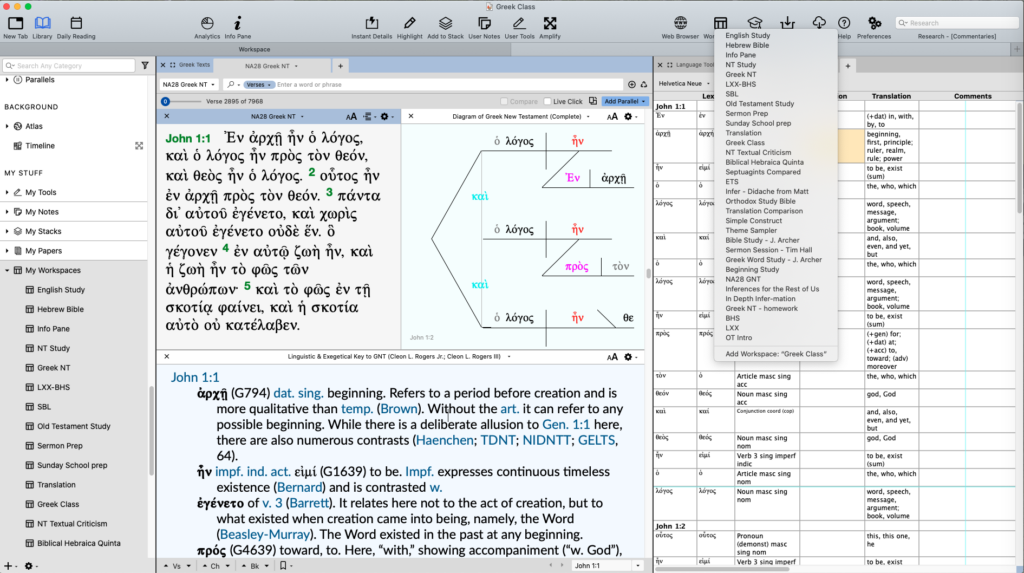Note: From 2016 – 2017, I wrote a series of blog posts titled “7 Strategies for Students Who Use Accordance.” This series was based upon an in-person seminar I had led a number of times, and now we also have a webinar by the same name. Although the vast majority of the content in these original posts is still relevant, it does not always incorporate some of the newer features in Accordance such as Papers, Stacks, and the internal web browser. And, of course, none of the screenshots reflect Accordance as it appears in v. 13. With that in mind, I’m offering updates to the original series with one new installment each week. These posts coincide with Fall semesters beginning again, so hopefully students beginning classes again can put these strategies to use as they use Accordance in their coursework.
Also, even if you’re not a student, you may find that most of the strategies I’ll be covering over the next few weeks just might make your work in Accordance a lot easier, too!
Initially, when I wrote the original 7 Strategies series, I saved this tip about creating Accordance Workspaces for last. However, in almost all the times I’ve presented this series in webinars over the past two or three years, I introduce it first because it’s something that can be reinforced throughout the entire series. Here’s the idea in a nutshell: Saving Workspaces save you time. Create a separate workspace for each course you’re taking. Include in it all the appropriate tools from Accordance that you will need in studying for that particular class.
A while back, a user asked me for help him with something he was trying to do in Accordance. He opened up his own laptop, launched Accordance, and began with, “This is something I do nearly every day.” Just to get to his question for me, he first had to build this very elaborate Workspace with multiple texts and reference works. After watching him do this, I said, “Wait—before we get to your question, let me ask you one. Do you create this Workspace every time you use Accordance?” He confirmed that he created this Workspace or one like it, from scratch, most of the time. Moreover, he started each launch of Accordance with his default Search Text. I introduced him to saved Workspaces and he still thanks me for it whenever I see him.
Every Accordance installation comes with five examples Workspaces: English Study, NT Study, Research, Simple Construct, Theme Sampler, and Translation Comparison. You can access these premade Accordance Workspaces from the Workspaces icon in the Toolbar or in the Library Pane under My Stuff: My Workspaces. If you don’t see all these workspaces in either location, look in your Accordance files folder in Documents (macOS) or My Documents (Windows).
Even if you’ve never saved one, you’re actually working from a Workspace, any time you’re in Accordance. If you find yourself going to the trouble of setting up Accordance to get it “just right” before you start using it each time, you should probably think about saving your Workspace so you can save time. The easiest way to do this is to go to the Workspace icon in the Toolbar and select Add Workspace. Now your newly saved Workspace will appear under the Workspace icon in the Toolbar and in the My Workspaces folder. Alternatively, go to the File menu and choose Save. Normally, when you save a Workspace from the File menu, it will automatically get added to the List in the Workspace icon dropdown menu on the Toolbar and in the list of My Workspaces in the Library menu.
Although every Accordance user can benefit from saving Workspaces, students will find this especially helpful. Consider that the way you use Accordance will be different in a preaching class than it will be in a New Testament Intro course or a beginner’s Hebrew, preaching, and so on. You’re going to use Accordance differently in every one of those situations, so why not save an Accordance Workspace for each class? This will save valuable time each time you sit down to study.
Here’s something else you should know: when you change a Workspace in your regular use of it, the saved file does not automatically update. This is on purpose in case you need to start fresh with a Workspace each time you use it. If you need the Workspace to keep your changes, make certain to use the Save or Save As command on the File menu to save your current work.
Accordance Bible Software has always been highly customizable. When you customize a specialized Workspace and then save it for repeated use, you’ve also made Accordance quite personal for your needs. And saved Workspaces are something you can continue to use long after you finish school.
Bonus tip: Workspaces don’t have to be saved in your Accordance files folder. I have hundreds of Workspaces saved in folders dedicated to particular projects I was working on at the time. If I need to revisit a particular area of research, not only do I have my notes, I have my Accordance Workspace there, too!
Other Posts in the series:
#2 Take Class Notes in Accordance


